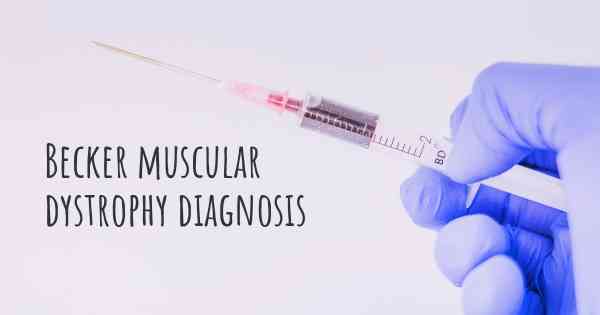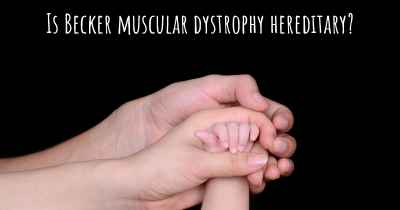How is Becker muscular dystrophy diagnosed?
See how Becker muscular dystrophy is diagnosed. Which specialists are essential to meet, what tests are needed and other useful information for the diagnosis of Becker muscular dystrophy

Diagnosis of Becker Muscular Dystrophy
Becker muscular dystrophy (BMD) is a genetic disorder characterized by progressive muscle weakness and wasting. It is caused by mutations in the dystrophin gene, which leads to a deficiency or abnormality of the dystrophin protein. BMD is similar to Duchenne muscular dystrophy (DMD), but it has a milder course and slower progression.
Medical History and Physical Examination
The diagnosis of Becker muscular dystrophy typically begins with a thorough medical history and physical examination. The healthcare provider will inquire about the patient's symptoms, family history, and any previous medical conditions. They will also assess the patient's muscle strength, range of motion, and look for any signs of muscle wasting or contractures.
Genetic Testing
Genetic testing is the most definitive method to diagnose Becker muscular dystrophy. It involves analyzing the dystrophin gene for mutations or abnormalities. This can be done through various techniques, such as DNA sequencing, multiplex ligation-dependent probe amplification (MLPA), or next-generation sequencing (NGS).
Genetic testing can identify specific mutations in the dystrophin gene that are associated with BMD. These mutations can vary in size and location, and different mutations may result in different disease severity and progression. Identifying the specific mutation can also help with genetic counseling and predicting the likelihood of passing the condition to future generations.
Electromyography (EMG)
Electromyography (EMG) is a diagnostic procedure that measures the electrical activity of muscles. It can be useful in the diagnosis of Becker muscular dystrophy by assessing the integrity and function of the muscles. During an EMG, small electrodes are inserted into the muscles, and the electrical signals produced by the muscles are recorded and analyzed.
In individuals with BMD, the EMG may show abnormal electrical activity, indicating muscle fiber damage and weakness. However, it is important to note that EMG findings alone are not sufficient for a definitive diagnosis of BMD, as they can also be seen in other neuromuscular conditions.
Muscle Biopsy
Muscle biopsy involves the removal of a small sample of muscle tissue for microscopic examination. It can provide valuable information about the structure and composition of the muscle fibers. In Becker muscular dystrophy, the muscle biopsy may reveal characteristic changes, such as muscle fiber degeneration, regeneration, and fibrosis.
However, muscle biopsy is not always necessary for the diagnosis of BMD, especially when genetic testing and clinical evaluation are conclusive. It is usually reserved for cases where the diagnosis is uncertain or when additional information is needed.
Other Diagnostic Tests
In addition to the aforementioned methods, other diagnostic tests may be performed to support the diagnosis of Becker muscular dystrophy:
- Blood tests: Blood tests can be conducted to measure the levels of creatine kinase (CK), an enzyme that is released into the bloodstream when muscle fibers are damaged. Elevated CK levels are often observed in individuals with BMD.
- Cardiac evaluation: As BMD can also affect the heart muscles, a cardiac evaluation may be recommended. This can include electrocardiogram (ECG) to assess the electrical activity of the heart and echocardiogram to evaluate the structure and function of the heart.
- Imaging studies: Imaging techniques such as magnetic resonance imaging (MRI) or ultrasound may be used to visualize the muscles and assess any structural abnormalities or fatty infiltration.
Conclusion
Diagnosing Becker muscular dystrophy involves a combination of medical history, physical examination, genetic testing, electromyography, and sometimes muscle biopsy. Genetic testing is the most definitive method, as it can identify specific mutations in the dystrophin gene associated with BMD. Other diagnostic tests, such as blood tests, cardiac evaluation, and imaging studies, may also be performed to support the diagnosis and assess the extent of muscle and organ involvement.
-Biopsy: caregivers remove a small tissue sample of one of their muscles and will be sent to the laboratory for examination.
-Telemetry is the continuous monitoring of your heart rate. Adhesive patches placed on your skin connect to an electrocardiograph (EKG or ECG) records the heart rhythm.
- Electromyography (EMG): This is also known as an EMG. An EMG is done to check the function of your muscles and the nerves that control them. Are placed electrodes (wires) on the area of the muscle that is going to be revised. Needles that enter your skin may be attached to the electrode. It measures the electrical activity of your muscles and nerves by a machine attached to the electrode. Your muscles are reviewed during rest and with activity.
-Genetic test: This test provides genetic information to see if, a hereditary disease, it is the one that is causing the problem.
-Magnetic resonance imaging: This test is also known with the acronym IRM. During the mri, pictures are taken of your muscles. Physicians use these images to determine if there are changes in the muscles...
Posted May 1, 2017 by NeEssy 1000








